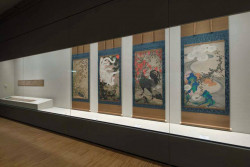
June 12, 2009
Hung Jury
Changes to Japan's legal system may energize the debate over capital punishment
By Metropolis
Originally published on metropolis.co.jp on June 2009
In December 1948, Sakae Menda was arrested in rural Kyushu on the charge of stealing some rice. This was a common crime in Japan’s hungry postwar years, and his case would have been open-and-shut had it not been for the murder of a Buddhist priest and the priest’s wife in a nearby town. Although Menda had an alibi that was supported by witnesses, he was arrested and interrogated for six days without food or water, after which he signed a confession that was the only evidence presented at his trial. Without even understanding the difference between the police station and the courtroom, Menda was tried, convicted and sentenced to death.
Each morning in solitary confinement, Menda listened as the sound of clinking keys approached his cell. A guard would pause outside the door, and the prisoner would become paralyzed with fear. Then the guard would move on. If the clinking keys stopped at another cell and the door swung open, the inmate inside would be led to the gallows. Menda endured this psychological torture every day for 34 years.
In 1983, after countless calls for a retrial, a court admitted that the police had suppressed evidence which supported Menda’s alibi, and he became the first person in Japan’s history to be released from death row.
Menda went on to become one of the country’s most vocal opponents of capital punishment. Shortly after his release, three other men were also exonerated and freed. More recently, a judge who handed down the sentence of a fourth man—this one on death row for 42 years—went public with his belief that trial evidence was fabricated. These high-profile cases have sparked a debate over capital punishment that continues today.
Reforms have moved slowly, however, as the whole system seems designed to prevent public or political discussion. Inmates are kept in solitary confinement, and visits by family and legal counsel are limited. Execution orders are given to guards and inmates on the same day they are carried out. Journalists, families of the condemned, and relatives of victims are never granted entrance to the execution chamber. You will not find the likes of Sean Penn and Sister Helen Prejean holding candlelight vigils outside prisons, as the public is only notified of executions after they occur. Until December 2007, even the names of the condemned were withheld from the public. Executions are scheduled when the Diet is not in session to prevent protest from opposition parties.
This secrecy has so separated the average person in Japan from state-sanctioned killing that the issue has become an abstraction for the public and a taboo for politicians. Yet capital punishment is not a hypothetical ethical dilemma, but an actual practice in which the government exterminates human life in our name.
Justice Minister Kunio Mori recently said that the time has come for public debate on the topic, prompted by Japan’s recent introduction of a trial-by-jury system. This system brings the public closer to the death penalty, as ordinary citizens may be called upon to decide on the ultimate sentence.
As it stands now, the public is overwhelmingly in favor of capital punishment—a 2005 survey found that over 80 percent of the population supports it. Mori has urged citizens to continue their support, saying the death penalty deters violent crime and maintains social order.
However, if the example of the US is anything to go by, that argument is wrong. In America, each state has the power to decide whether to allow capital punishment, and those states that use the death penalty consistently have higher murder rates than those that do not. While such statistics don’t conclusively prove that deterrence doesn’t work, they likewise fail to support the argument that it does. If the death penalty were lifted in Japan, the murder rate would rise, fall, stay the same—or, most likely, do some combination of the three over time. But it would be impossible to prove or disprove any connection to the lack of capital punishment.
Much more specious is Mori’s claim that social order is supported by destroying human life on behalf of the citizenry—in effect, forcing us to kill whether we support the death penalty or not. The new jury system has brought the people of Japan closer to a practice that has always weighed on them and, hopefully, one step closer to rejecting this practice.
The last word goes to Sadamichi Hirasawa, another long-term death row inmate who many now feel was unjustly condemned—but who, unlike Menda, died of natural causes in prison. Explaining why he fought to prove his innocence and to end capital punishment, Hirasawa said, “I am trying to get rid of a misfortune imposed on all people in Japan.”








